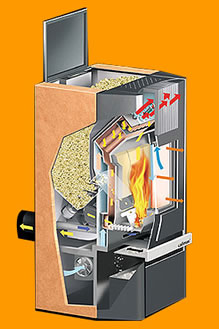


What Are Pellet Stoves?
|

First, what are they? Unlike traditional stoves, pellet stoves don’t burn wood, but wood pellets stemming from waste chips and recycled sawdust. Corn pellets can also be used, but these are harder to find. Smoke from the stove comes out clear. It is vented through a pipe as opposed to a chimney. The heat from a pellet stove can warm even the reaches of a two-story house, often eliminating the need to turn on your central heating system. While the fuel used for the pellet stove is environmentally friendly, the appliance requires plugging into an electrical outlet.
What do they look like? Another plus for the pellet stove: its good looks. It has the homey aura of a traditional, wood burning stove, without the side effect of emitting hundreds of pollutants into the air. Pellet designs vary significantly. Homeowners with modern sensibilities can select a trendy model in bright, bold colors. Other models are rustic and warm. And then there are endless varieties in between from companies such as
Why are they good for the environment? Being green is surely the best quality among the pellet’s many good qualities. Pellet stoves pollute less than EPA certified wood stoves or any other heating appliances that uses solid fuel. When properly installed, pellet stoves also has little adverse affect on indoor air.
|
|
| What size stove or fireplace should I get for my home? | This is a good question. Too small, and you’ll not be warm enough. Too big, and you’ll have to keep your fires burning low (smoldering) which increases harmful emissions and lowers efficiency. Manufacturers include with their product information the square footage each unit should heat. However, there are many factors to consider. These include the climate you live in, how old your house is and the condition of its windows and insulation. You’ll also want to think about the layout of your home. If it’s fairly open with good circulation and you’d like to heat your whole house, you’ll want something bigger than if you’re just looking to heat one or two rooms. Come in to our showroom and we can help you sort all this out. | |
What is the difference between a stove, insert or a fireplace? |
Freestanding stoves stand alone on legs or pedestals with hearth protection underneath. They are by far the most popular purchase, as they are usually the least expensive and most flexible way to heat. These also can be chosen to burn wood, gas, pellets or electricity.
Fireplace inserts are used to make an existing masonry or steel fireplace energy efficient and environmentally friendly while maintaining the beauty of the original fireplace. They are inserted into the open space which had previously drawn warm air up the chimney and out of the home. These also can be chosen to burn wood, gas, pellets or electricity.
Fireplaces are built into your home. You frame around them with your choice of brick, stone, tile, etc. They can burn wood, gas, pellets or electricity. |
|
| What will I save in fuel costs? | Pellet fuel is a cost stable and price competitive fuel. A good way to understand the price benefits of pellet fuel is to compare it against other home heating fuels.
Here is a handy calculator for pellet vs gas fuel. Compare Fuel Costs |
|
Brands We Carry |
|
|
